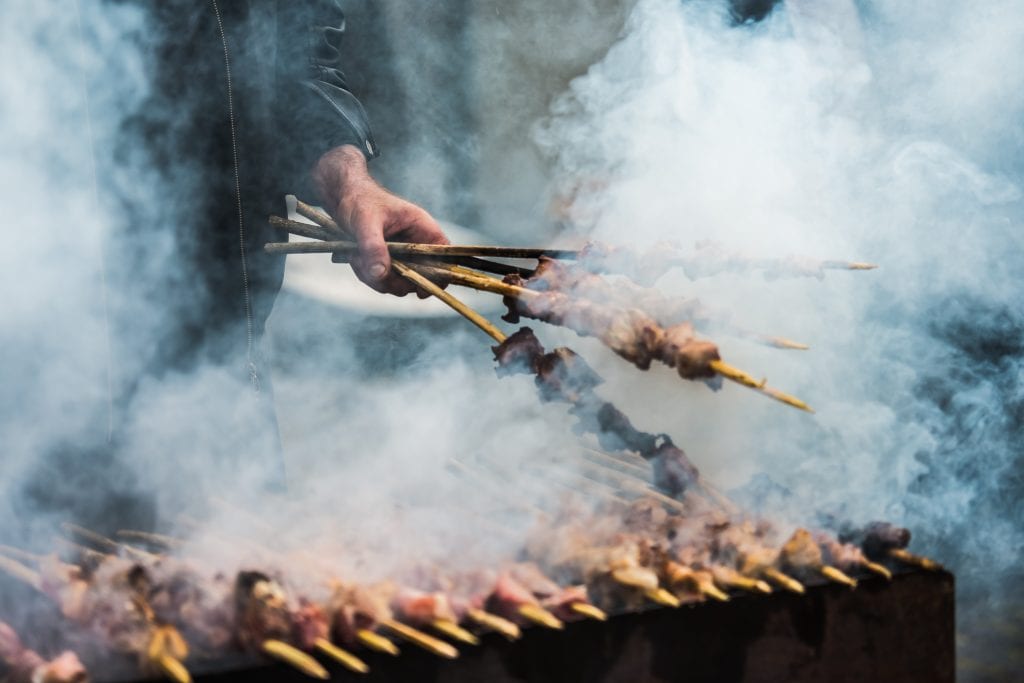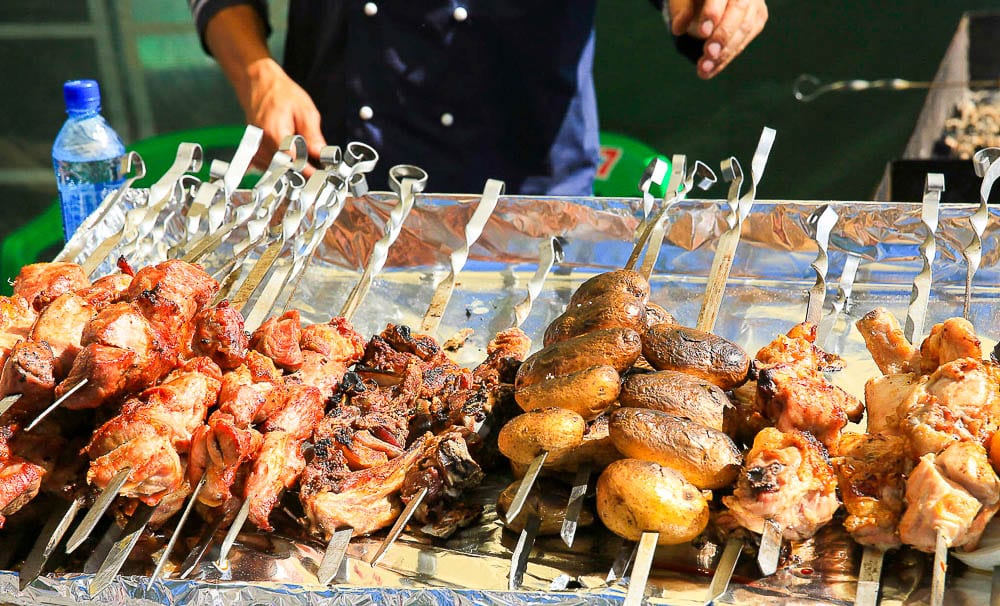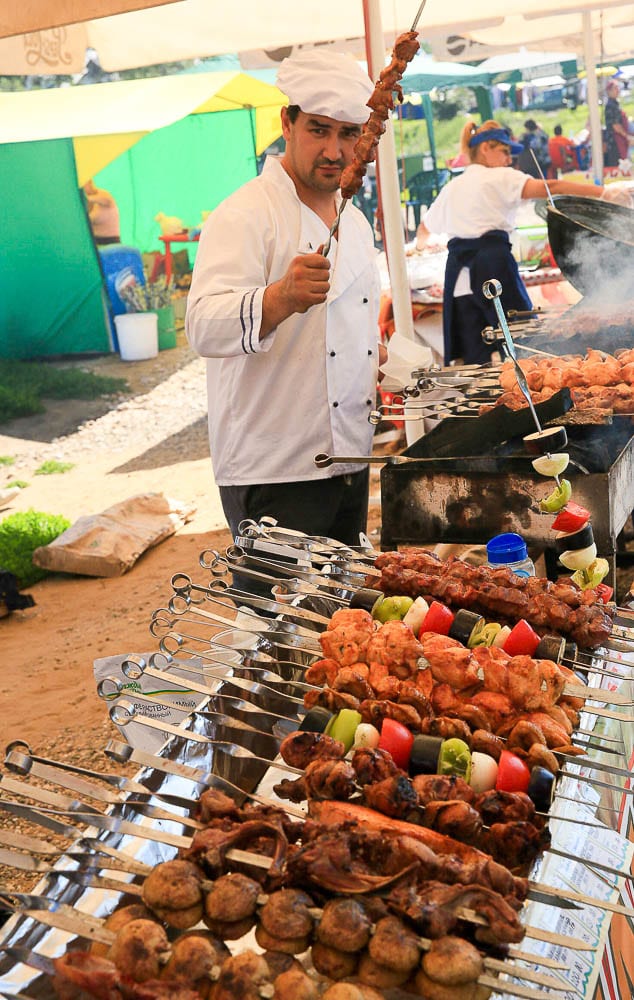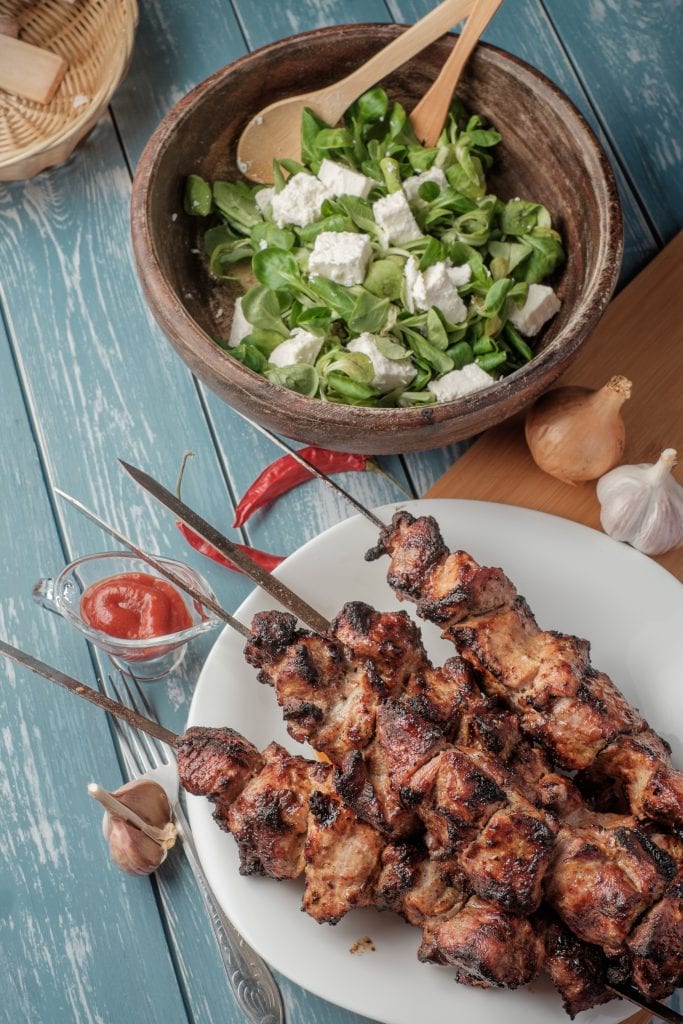I’m headed outside of the city to the dacha to fire up the grill and make some Russian shashlik.
Summer is just around the corner in Russia, and with it comes with the first whiff of the pungent smoke of the “kostor” or barbecue grill. As the lilac comes into full bloom, the “snowdrops,” those rickety, rusty, banjaxed cars used only to get to country houses, or “dachas,” from May to August bounce out or the city, where, even if the dacha has electricity, and many do not, the menu is traditional and unchanging: shashlik: skewers of marinated pork or lamb grilled over an open wood fire.
The Origins of Shashlik
Though a major culinary staple, shashlik is not native to Russia. Like so many culinary staples, Russians adapted it from their southern neighbors in the Caucuses, and, like the much of the Caucuses, Russians have made it their own.
Or, should we say, Russian men have made it their own? Russian men do not naturally gravitate to cooking as it involves neither world domination, fast driving, or Kalashnikov rifles. Cooking often involves cleaning, multi-tasking and long-range strategic planning, so it doesn’t score in the single digits on their bucket lists. Cooking isn’t madly them.
The big exception is shashlik, which, Russian men assert “cannot tolerate woman’s touch.”
Sidebar? I’ve noticed that shashlik seems able to tolerate a woman’s touch during the tedious preparation and challenging clean up.
Russian men throw themselves into this sole culinary endeavor with gusto: spirited debates over the exact chemistry of the secret ancestral marinade (consisting of vinegar, oil, salt and pepper), and the proper arrangement of kindling in the “kostor” last as long as it takes to consume a bottle of vodka. Tenderly and lovingly, they spear the clammy chunks onto lethal meter-long shashlik imaplers, and carefully lower them onto the flames.
I sometimes think that if each Russian man lavished this kind of attention on his wife, the burning issue of Russia’s declining birthrate could be solved overnight.
Grill Shashlik over an Open Fire
Shashlik should really be barbecued over open flames (preferably wood) in a “mangal’” or hibachi-style grill. You can use the following recipe on a gas grill or under a broiler if need be, but the shashlik will lack that smokey, slightly charred taste that makes it unique.
Dacha Shashlik:Ingredients 2 kilos (5 lbs) of pork or lamb, cubed250 ml (1 cup) of red wine vinegar or red winecold waterThe juice and zest of one lemon125 ml (1/2-cup) of fresh pomegranate juice or 60 ml (4 Tbl) of pomegranate syrup2 Tbl of whole juniper berries, slightly crushed in a mortar and pestle30 ml (1/8-cup) of fresh coriander seeds, crushed5 sprigs of dill60 ml (4 Tbls) of peppercorns, coarsely crushed in a mortar and pestle60 ml (4 Tbls) of coarse sea salt1 yellow onion, peeled and roughly chopped8 cloves of garlic, crushed125 ml (1/2-cup) of olive oilChopped fresh cilantro (coriander)
All of the ingredients for Dacha Shashlik are best sourced from the farmers’ markets, a good supermarket, or a reliable organic supplier such as LavkaLavka. Recipe Source: https://jennifereremeeva.com |
Riffing on Shashlik:
You can make shashlik from just about any kind of meat. The grilling technique is the same. To prepare the meat, note the slight tweaks below for each kind of shashlik.
Beef Shashlik:
Use 2 cups of a good, strong red wine in the marinade above. Add a bit more salt and some fresh thyme to really make it zing.
Lamb Shashlik:
Instead of the marinade, coat the lamb with the following paste, cover with plastic wrap and let sit for at least 3 hours:
Ingredients:
30 ml (2 Tbl) of Anchovy paste
30 ml (2 Tbl) of Tomato paste
125 ml (1/2-cup) of Dijon mustard
Lemon zest
5 cloves of garlic, mashed and chopped with salt
45 ml (3 Tbl) of fresh rosemary
Fish Shashlik:
– Use a firm fish such as salmon. Toss the cubes in lime juice and good quality coarse salt. Coat with olive oil and grill until the fish turns opaque. Serve with yogurt and dill sauce.
Chicken Shashlik:
-Prepare the same marinade as above, substituting white wine for the red wine/red vinegar and use boneless chicken thighs.
Vegetarian Shashlik (If you must):
-Use peppers, mushrooms, onions, zucchini, and cherry tomatoes on your skewers. Halloumi cheese works well, or serve with fresh Bulgarian brynza.
-Russian shashlik stands, such as the ones pictured in this post often use new potatoes on a skewer as a side dish. I don’t think this is the best approach: too starchy and too much of a filler.
Do not use tofu. Just don’t.
Sauces for Shashlik:
For each kind of shashlik, there exist an equal number of traditional garnishes. I’ve been saddened in recent years to see large plastic bottles of Heinz ketchup appear at shashlik parties. These need to be banished. If you live in Russia, there is nothing better than the sauces of the Caucuses, which combine the tartness of citrus, musky flesh fruits, and salt with fresh herbs. Try Tkemali (sour plum sauce) or Adzhika fresh from the market, or sold in bottles in most supermarkets.
Pork Shashlik lends itself to the tangy yogurt-based sauces of the Balkans and the Baltic States: whisk Greek yogurt together with snipped chives, crushed garlic, lemon juice, and olive oil.
Shashlik Sides:
Traditionally, shashlik stands alone – not accompanied by any fancy salads or complicated garnish. Russians serve fresh vegetables of the season such as tomatoes, peppers or cucumbers with only salt to season them. The reasons for this are primarily practical: shashlik is prepared and eaten in the outdoors, or in the back garden of a dacha which may well lack refrigeration, sharp knives, or electricity to facilitate preparation and storage.
Russians are wise to avoid heavy, starchy accompaniments such as potatoes or the mayonnaise-based salads, which often grace a Russian indoor zakuska or hors d’oeuvre course. Complicated accompaniment can also take away from the pure flavor of the freshly grilled meat, tinged with the smoke of the kostor, freshly mown grass and hint of pine. In our Russian/American family, we’ve experimented with different culinary traditions to find side dishes, which compliment shashlik while not upstaging it. Lighter, citrus-based salads with tangy herbal dressings seem to be the perfect match for enhancing shashlik without stealing its thunder.
Note: these are not traditional Russian salads, but they are made from ingredients readily available in Russia and make frequent appearances at our table in Moscow.
Black Beluga Lentil Salad
I brought this recipe with me to Russia from my childhood in New England, where it was always referred to as “Lentil Sludge,” and I don’t think there has been a piece of lamb on my table without these for the last twenty years. When I first came to Russia in the early 1990s, puy lentils were almost impossible to find, so I made do with the abundant green lentils. The tang of ginger and the red wine vinegar are a perfect foil to lamb, while the fresh scallions and peppers provide the essential “crunch” to the meal’s ensemble.
See the recipe here.
Lemon, Tomato, and Basil Salad:
I readily confess to being a raging tomato snob! Each March, I hold my breath and wait for the price of Baku beef tomatoes to drop like a stone and then I literally eat them for breakfast, lunch, and dinner until about October, when the price shoots up again and the flavor isn’t as fresh.
See more dishes with Russia’s bountiful tomato crop here.
In Moscow, we are lucky enough to have a roof garden with a grill, where we eat some form of grilled meat most evenings from May to September. This salad appears with almost every dinner during the summer, and when it doesn’t appear on the table, family and friends protest violently! They all ask for the recipe, which makes me laugh, since it isn’t really even a recipe! It’s a conclave of perfectly calibrated ingredients. The best kind of recipe!
Lemon, Tomato, and Basil Salad:Ingredients:1 kilo (2 lbs) of small fresh tomatoes, cherry tomatoes, or sliced beef tomatoes — the freshest and best you can find. A drizzle of good quality olive oil Juice of one fresh lemon 30 ml (2 Tbls) of sugar Generous handful of basil leaves, coarsely chopped One loaf of French bread Instructions:
Why the bread? To soak up the delicious juices from this salad, mingled with the drippings from the meat. Delicious! |
“Granny Pasta”
My nieces are vegetarians, so when we are together, we often to serve some form of this light, but nourishing pasta dish for them, and this is my daughter, Velvet’s favorite picnic dish for her horse shows. As the name suggests, my mother – their grandmother – invented this and it’s great as a side dish to shashlik, as well as on its own. I made it for a group of guests recently and a very polite, but I think sincere 14 year old looked down at his plate of Granny Pasta and barbecue, sighed deeply, and said, “This is the perfect meal.” And so it is!
“Granny Pasta”Ingredients1-500 gram (1 lb) box of penne pasta 125 ml (1/2-cup) of olive oil 250 ml (1 cup) of fresh green basil leaves, shredded. Malden salt Pepper 250 ml (1 cup) of grated cheese: we use Asiago or Parmesan Reggiano, but I’ve also used goat cheese, sheep’s cheese, or just the ends of the cheeses left in my fridge! In this day and age in Moscow, use what you have in the fridge! Instructions:
|
Priyatnogo Appetitita!
An earlier version of this article appeared in Russia Beyond the Headlines in July, 2011. A link to the original article can be found here.













Great shashlik recipes! I love juniper berries, and have never thought of using them for shashlik. And I’ve never heard of anchovy paste for lamb shashlik, sounds interesting, will have the try it! Thanks for posting! Love your blog
Peter,
Try putting juniper berries in a gin and tonic….you’ll thank me!
Jennifer
Great idea, Thanks for that, I’ll try it! During Christmas, I put them in a pestle and mortar with peppercorns, smash them all to death and use them my turkey gravy as seasoning. Adds a great zing! 🙂
I just posted a recipe for a sweet Kumquat Nastoyka (настойка), but I wonder what I can concoct with Juniper berries…… ideas ideas….. Thanks!
Peter
Thanks For Sharing this amazing recipe. My family loved it. I will be sharing this recipe with my friends. Hope the will like it.